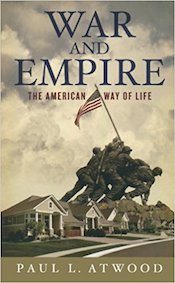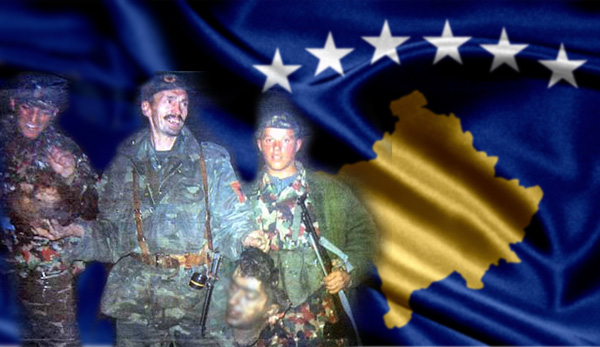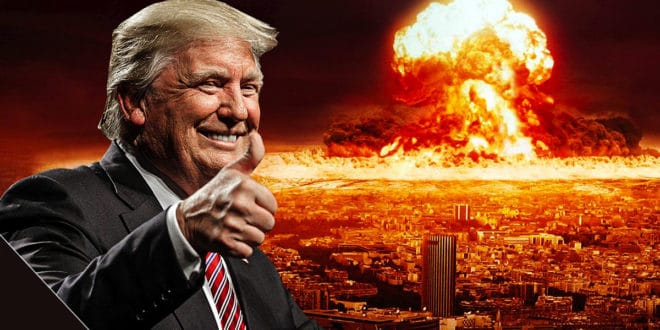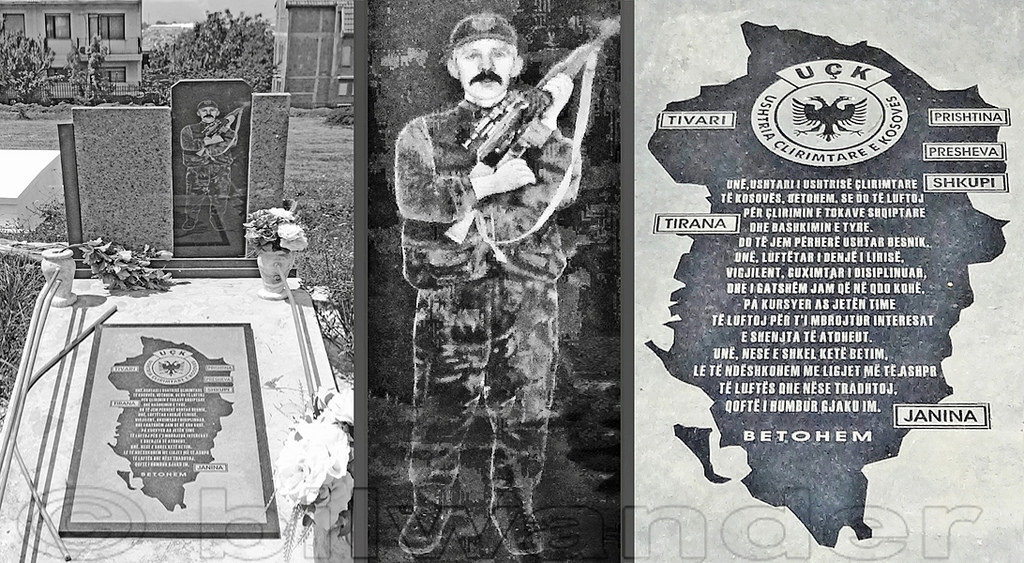
Views: 3398
Michigan-based filmmaker Michael Moore makes the connection between Kosovo and the Columbine shooting in his Academy Award-winning documentary Bowling for Columbine (2002). Moore puts Kosovo in the context of a broader U.S. foreign policy agenda and a domestic culture of violence. Moore asks: “Are we a nation of gun nuts or are we just nuts?”
In the first scene, Moore walks into the North Country Bank in Michigan to open an account. He saw an ad in the newspaper that the bank would give out free guns to those who open accounts there. Moore walks into the bank and tells the teller that he wants to open an account there. The teller asks him what type of account he wants. Moore answers:
“I want the account where I can (pause) get the free gun.”
The bank functions as a bank and as a licensed fire-arms dealer. Moore fills out an application and is given his free gun, a rifle. Moore asks the bank employee:
“Do you think it’s a little dangerous handing out guns in a bank?”
Moore is shown leaving the bank with the rifle slung over his shoulder. Fact is stranger than fiction. Moore understands this perfectly. You don’t have to invent anything, merely observe. His analysis and satire work perfectly to show the absurdity of the American obsession with violence and guns. Guns and violence do not make us more secure, but only feed our paranoia and feelings of panic and fear and insecurity.
Moore analyzes the “gun culture” and obsession with violence and fear and paranoia in America. To understood the Kosovo conflict, you have to understand the US “psyche” and US culture and US foreign policy. The Kosovo conflict is Made in the U.S.A. You cannot comprehend the conflict without an understanding of the US culture of violence, the American “psyche” or national character.
 Moore uses the Kosovo conflict and the illegal US and NATO bombing of Yugoslavia in 1999 to show the connection between a society and culture of violence and the implications for US foreign policy. The bombing of Serbia by the US is central to the plot of the Oscar-winning movie Bowling for Columbine. Kosovo is central to the movie.
Moore uses the Kosovo conflict and the illegal US and NATO bombing of Yugoslavia in 1999 to show the connection between a society and culture of violence and the implications for US foreign policy. The bombing of Serbia by the US is central to the plot of the Oscar-winning movie Bowling for Columbine. Kosovo is central to the movie.
In the key scene of the movie, the date “April 20, 1999” flashes on the screen. This was the day of the Columbine shooting in Littleton, Colorado. This was also the “largest one day bombing by the U.S. in the Kosovo war.” Moore plays news footage for that day. The announcer notes that “22 NATO missiles fell on the village of Bogutovac near Kraljevo. Deadly cargo was dropped on the residential part of the village.” This village is in lower central Serbia, not Kosovo, located in southern Serbia. The mutilated and contorted corpses of several Serbian civilians were shown. Then a news conference with US President Bill Clinton was shown. Clinton rationalized the civilian killings and the massive destruction to civilian buildings. Clinton said that the US wanted to “minimize harm to innocent people.” The announcer reported: “On the hit list were a local hospital and primary school.”
Here is a link to photos from the US bombing of Yugoslavia in 1999.
Then Moore segues into the Columbine shooting. On the screen flash the words: “One Hour Later.” One hour after Clinton tried to explain away the murder of innocent Serbian civilians, Clinton again appeared on US national TV to explain the Columbine shootings. Clinton announces: “We all know there has been a terrible shooting at a high school in Littleton, Colorado.”
Moore’s central thesis is that there is a direct link between the US murders of Serbian civilians and the murders at Columbine high school. To understand the former you have to understand the latter. And to explain both, you have to understand US foreign policy during the Cold War and the American culture of violence, a gun culture rooted in racial paranoia and fear. “Happiness is a warm gun.”
The movie opens with Moore describing April 20, 1999 as a typical day in the US. The farmer did his chores. Moore shows a scene of James Nichols, the brother of convicted Oklahoma bomber Terry Nichols, working on his tofu farm in Decker, Michigan. Moore then shows bombing damage from US air strikes in Serbia. Moore says: “The President bombed another country whose name we couldn’t pronounce.”
Moore then sets out to explore why the Columbine shooting happened. Why did the kids do that? Why did they murder their fellow students and a teacher in cold blood that day? How do you explain such mindless and senseless violence?
Lockheed Martin, the largest weapons and arms manufacturer in the world, is located outside of Littleton. Moore seeks to find a connection between Lockheed and the manufacture of weapons and the Columbine shooting. The US is the largest weapons and arms exporter in the world. The US has the largest military budget in the world. Lockheed is also the largest employer in Littleton. NORAD is located outside Littleton, as is a closed-down plutonium plant. Moore also showed the B-52 bomber monument with a plaque that honored the killing of Vietnamese civilians. Does Littleton’s proximity to this military and arms nexus have anything to do with a culture of violence?
Moore interviewed Evan McCollum, the public relations spokesperson for Lockheed. Moore asked him whether he saw a connection between the “mass destruction” that Lockheed creates in the world and the “mass destruction” that occurred in Columbine. Isn’t it the same? Doesn’t Lockheed make weapons of mass destruction that kill innocent people around the globe so that Americans can earn their living and corporations can earn their profits? When in doubt, we bomb. We bomb early and often. Bombs or ballots? What good are bombs if you don’t use them? What good are ballots if the opposition wins? McCollum denied the connection. The US does not export violence and does not murder and kill innocent civilians around the world. We don’t bomb other countries just because they don’t kiss our asses and buy our Big Macs and Whoppers. We bomb for all the right reasons.
Moore then had a satirical refutation of McCollum’s rhetorical claims. With a recording of Louis Armstrong’s 1968 non-hit “What a Wonderful World” playing in the background, Moore then showed footage of the 1953 US ouster of Prime Minister Mohammed Mossadeq in Iran, who was democratically elected. Mossadeq sought to help the Iranian population exploited by foreign oil interests. The US instigated a “regime change” of this democratically elected reform leader and put in his place the Shah as dictator, who would protect US and British oil interests at the expense of the Iranian people. Could this have anything to do with the 1979 Iran hostage crisis and Iranian rage against the United States? In 1954, the democratically elected Jacobo Arbenz government in Guatemala was overthrown by the CIA and a military junta under US-installed dictator, Colonel Carlos Armas, was imposed, who subsequently murdered thousands of civilians. Arbenz initiated land reforms that would help the Guatemalan poor but which threatened the property holdings of the US company United Fruit. United Fruit, closely linked with the CIA, compelled the CIA to organize a regime change. The US-installed junta murdered 200,000 Guatemalans.
During the Vietnam War, US forces killed four million Vietnamese civilians in order to maintain in power a US-installed dictator, Ngo Diem. The US had initially installed Diem to prevent democratic elections that would express the majority will of the Vietnamese population. On November 2, 1963, US President John F. Kennedy approved the assassination of Diem, who was murdered by a more subservient dictator. Diem’s wife, Madame Nhu, blamed the US government for the assassination: “Whoever has the Americans as allies does not need enemies.” Twenty days later, Kennedy would himself be assassinated.
In 1973, the democratically elected Salvador Allende regime was overthrown by the US after a three year regime change campaign by the CIA that began in 1970 when the US tried unsuccessfully to prevent his assuming his elected office of President of Chile. The US put in the genocidal dictator Augusto Pinochet. The US right-wing puppet Pinochet then murdered 5,000 Chilean civilians, the “disappeared”. In 1977, the US backed the El Salvadoran military forces and death squads who murdered 70,000 civilians and four US nuns.
Nothing shows the true American national character better than US support of Saddam Hussein, the Ayatollah Khomeini regime in Iran, and Ossama bin Laden in the 1980s. In 1982, Moore alleged that the US gave Saddam Hussein “billions in aid” so he could continue the war against Iran. Donald Rumsfeld even flew to Baghdad to personally meet and greet our staunchest ally, Saddam Hussein. In 1983, the US sought to provide Iran arms and weapons to kill Iraqis, the Iran-Contra operation spearheaded by Oliver North under the Ronald Reagan administration. The US was supporting both sides in the Iraq-Iran conflict. The US just wanted Muslims killing Muslims. There was nothing about “freedom” and “democracy” and “genocide”. It was just about getting Muslims to kill other Muslims. It was a quite simple game back then. In 1991, the US returned to power the dictator Emir Jaber Al-Sabah in Kuwait, a country where only 15% of the population could vote and where women were not allowed to vote. Kuwait was of vital strategic importance to the US because of US reliance on Gulf oil.
Moore explained how the Clinton administration bombed an aspirin factory in Sudan in 1998 which it mistook for a terrorist base. Indiscriminate bombing substitutes as a band-aid solution for a failed foreign policy. Before the 2003 invasion of Iraq, the US had killed what the UN had estimated as “500,000 Iraqi children” through sanctions and non-stop bombings in the no-fly zones.
A remarkable revelation is that Clinton gave the Taliban government in Afghanistan $245 in aid during 2000-2001, just before the 9/11 attack, which was planned and organized in Taliban-ruled Afghanistan, the home base for Al-Qaeda. Finally, Moore alleges that Ossama bin Laden used his CIA training as a US-backed and US-funded mujahedeen “freedom fighter” in Afghanistan to plan the 9/11 attacks. Moore alleges that the US gave the mujahedeen $3 billion in aid during the 1980s. The US training by the CIA came in mighty handy for 9/11, as did the $245 million in aid from the Clinton administration.
Are guns the problem then? Do we just get rid of all the guns? Cruise missiles and guns and air strikes are just the outer manifestations of a deeply-ingrained American culture of violence and insecurity and fear. Moore explained it this way. Even if we got rid of all the Tomahawk cruise missiles and guns, “we would still have the psyche problem—the problem that says we have a right to resolve our disputes through violence. That’s what separates us from other countries.”
This is something that has to be understood if anyone wants to grasp the Kosovo conflict. This is a movie everyone should see. Here is a link to the Bowling for Columbine site.
This is a link to the War Crimes Complaint against William J. Clinton et al.
Originally published on 2006-09-26
Author: Carl K. Savich
Source: Serbianna
Origins of images: Facebook, Twitter, Wikimedia, Wikipedia, Flickr, Google, Imageinjection & Pinterest.
Read our Disclaimer/Legal Statement!
Donate to Support Us
We would like to ask you to consider a small donation to help our team keep working. We accept no advertising and rely only on you, our readers, to keep us digging the truth on history, global politics and international relations.
FOLLOW US ON OUR SOCIAL PLATFORMS










